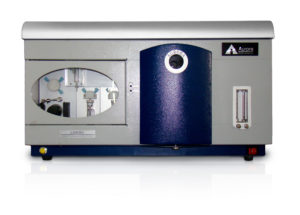
PRODUCT INFORMATION
Aurora’s Atomic Fluorescence Spectrometers offer exceptional sensitivity, precision, and accuracy for detecting hydride-forming elements and mercury at parts-per-trillion (ppt) levels.
Using a vapor hydride generator, this system is ideal for biochemical, medical, and chemical applications requiring ultra-low detection limits. Trusted for both research and industrial use, Aurora’s instruments deliver reliable, high-performance elemental analysis across a wide range of sectors.
Applications
Metallurgy · Geology and Mining · Petrochemical · Pharmaceutical Quality Control · Agriculture and Environmental Monitoring
Frequently Asked Questions
In atomic fluorescence spectroscopy, similar to the related technique of atomic absorption spectroscopy, a sample absorbs light at a particular wavelength to promote its electrons from its ground electronic state into an excited state. From this excited electronic state, the electron drops down to a lower electronic state, emitting a photon with a specific wavelength in the process. By measuring the intensity of the emitted light at particular frequencies, it is possible to determine the concentration of the element in question via atomic fluorescence spectrometry.
The LUMINA series of Atomic Fluorescence Spectrometers provide sub-trace detection and elemental analysis of hydride-forming elements. The unique vapor/hydride generator provides enhanced sensitivities and reduced interferences for the detection of Mercury (Hg), Arsenic (As), Cadmium (Cd), Zinc (Zn), Bismuth (Bi), Selenium (Se), Tellurium (Te), Antimony (Sb), Tin (Sn), Germanium (Ge), and Lead (Pb).
The detection limit for the following elements is specified in the table below:
| Element | Detection Limit (μg/L) | RSD (%) |
| As, Se, Pb, Bi, Sb, Te, Sn | 0.01 | <1.0 |
| Hg, Cd | 0.001 | <1.0 |
| Zn | <1.0 | <1.0 |
| Ge | <0.05 | <1.0 |
The LUMINA AFS system uses a quartz tube furnace with an interference-reducing Ar-H2 diffusion flame. This flame is ignited automatically within the instrument. The LUMINA AFS system is also equipped with a two-stage gas/liquid separator and a filtered, integrated exhaust system that can efficiently decontaminate pollutants during sample preparation and delivery steps.
Yes, the LUMINA AFS system utilizes the Cold Vapor method for mercury detection. Mercury analysis is a critical component of food and water safety, agriculture, and environmental monitoring. Samples must be digested prior to analysis to ensure accurate analyte measurements.
Yes, the Cold Vapor method used by the LUMINA Atomic Fluorescence Spectrometer is recommended by the USFDA for the detection of Mercury at ppb or sub-ppb levels.
Yes; for example, the LUMINA AFS system has a detection limit for mercury of 1ppt, which is comparable to literature-reported detection limits for mercury with ICP-MS. Additionally, the plasma temperatures utilized in ICP-MS may be too hot for accurate mercury analysis, leading to premature mercury decomposition and thus unreliable results.
Yes, the LUMINA includes an optional XYZ autosampler for sample introduction that hosts a maximum of 192 standard cup/test tube sample racks. It is compatible with standard solvent extraction test tubes, ICP test tubes, and custom-made trays.
The LUMINA Atomic Fluorescence Spectrometers are equipped with specially-designed high intensity Hollow Cathode Lamps (HCL) with 2-channel independent power supplies, providing improved sensitivities and lower detection limits. It also features dual channel, simultaneous two-element analysis, using a computer-controlled pulsed light source.





